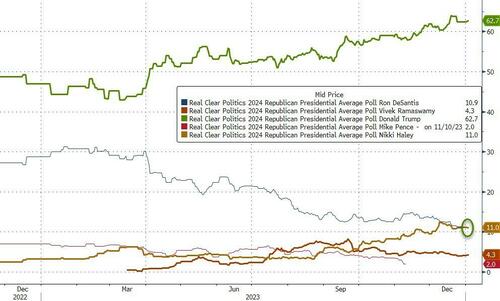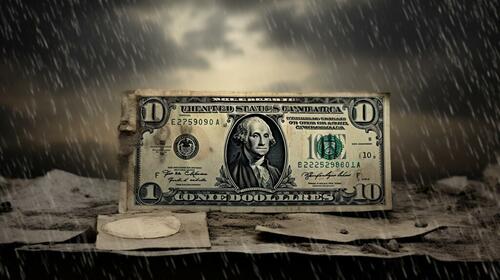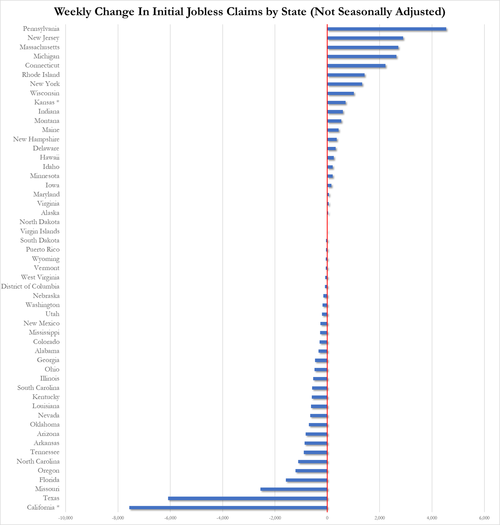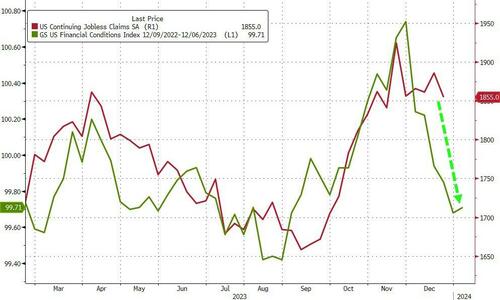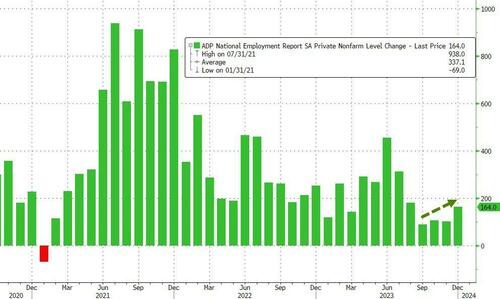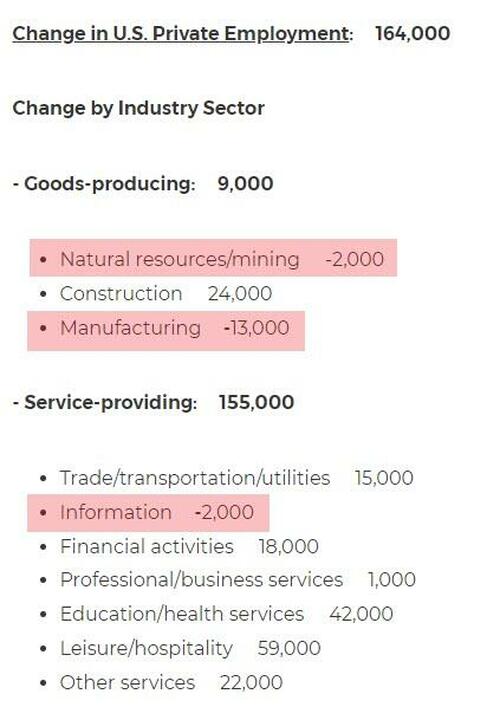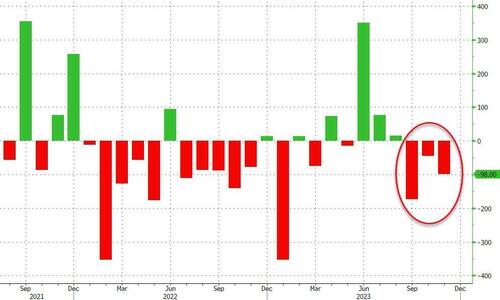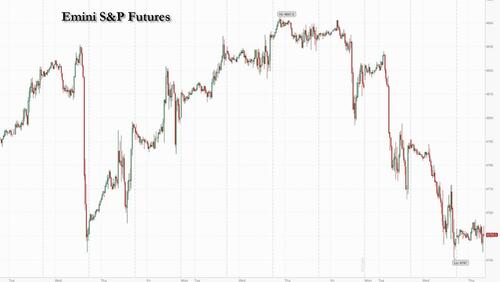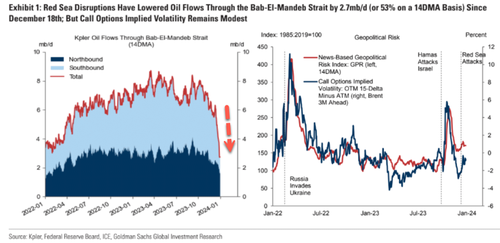Authored by Thomas Buckley via The Brownstone Institute,
Covid has claimed about 105,000 lives in the state since 2020.

In that same time period, 82,000 more Californians died from everything else than is typical.
Adjusted for the decline in population, that non-Covid “excess death” figure becomes even more concerning as the state has seen its population drop to about the same it was in 2015.
In 2015 – obviously there was no Covid – 260,000 of the then 39 million Californians died.
In 2023, not including November and December, 240,000 people died not from Covid (6,000 additional people died of Covid.).
Extrapolating the year-to-date figures for 2023 creates a final year-end figure of 280,000 – 20,000 more people than died in 2015. That’s a non-Covid, population-neutral jump of 8%.
In other words, despite the protestations of certain officials, the state’s death rate has NOT returned to “pre-Covid” levels – in 2019 the year before the pandemic, 270,000 people died with a population at least 400,000 greater than today.
Why?
Dr. Bob Wachter, medical chair at UC-SF and ardent supporter of tight pandemic restrictions, did not respond to an email from the Globe (away for work the auto-response said) but he did recently tell the San Jose Mercury News that in “(T)he last three years, not only were there a lot of deaths from Covid, there were a lot of additional deaths from non-Covid causes, which are probably attributable to people not receiving the medical care that they normally would have received’ when ERs were overflowing with Covid patients (note – the truth of that ER assertion has not been verified), Wachter noted.”
In other words, the pandemicist Wachter admitted the pandemic response itself at least contributed to a significant number of excess deaths, a fact that was aggressively and roundly denied and – if mentioned – led to censoring and societal ostracization (and in many cases job losses) by the powers that be during the pandemic.
A second admission along these lines was recently made by former National Institutes of Health Director Dr. Francis Collins – Tony Fauci’s boss.
In this video clip, Collins – who once called for a “devastating takedown” (see above) of those who questioned the hard pandemic response – said his DC and public health blinders, well, blinded him to the problems his pandemic response caused and is still causing:
If you’re a public health person, and you’re trying to make a decision, you have this very narrow view of what the right decision is, and that is something that will save a life. Doesn’t matter what else happens, so you attach infinite value to stopping the disease and saving a life. You attach zero value to whether this actually totally disrupts people’s lives, ruins the economy, and has many kids kept out of school in a way that they never might quite recover from. Collateral damage. This is a public health mindset. And I think a lot of us involved in trying to make those recommendations had that mindset — and that was really unfortunate, it’s another mistake we made.
(You can see Collins for yourself here.)
Needless to say there is not even a half-hearted apology involved. And Collins is/was wrong in the approach to public health he apparently subscribes to, as throughout modern history it has involved a cost/benefit analysis and a weighing of the impact on society.
Public health, practiced properly, does not – and never before has – attached “zero value to whether this actually totally disrupts people’s lives, ruins the economy, and has many kids kept out of school in a way that they never might quite recover from.”
“We had the exact wrong people in charge at the exact wrong time,” said Stanford professor of medicine (and one of the people Collins tried to “take down”) Dr. Jay Bhattacharya.
“Their decisions were myopically deadly.”
To remind Collins of the ramifications of his decision beyond the excess deaths:
Massive educational degradation. Economic devastation, by both the lockdowns and now the continuing fiscal nightmare plaguing the nation caused by continuing federal overreaction. The critical damage to the development of children’s social skills through hyper-masking and fear-mongering. The obliteration of the public’s trust in institutions due to their incompetence and deceitfulness during the pandemic. The massive erosion of civil liberties. The direct hardships caused by vaccination mandates, etc. under the false claim of helping one’s neighbor. The explosion of the growth of Wall Street built on the destruction of Main Street.
The clear separation of society into two camps – those who could easily prosper during the pandemic and those whose lives were completely upended. The demonization of anyone daring to ask even basic questions about the efficacy of the response, be it the vaccines themselves, the closure of public schools, the origin of the virus, or the absurdity of the useless public theater that made up much of the program. The fissures created throughout society and the harm caused by guillotined relationships amongst family and friends.
The slanders and career chaos endured by prominent actual experts (see the Great Barrington Declaration, co-authored by Bhattacharya) and just plain reasonable people like Jennifer Sey for daring to offer different approaches; approaches – such as focusing on the most vulnerable – that had been tested and succeeded before.
Nationally, pandemic “all-cause” deaths spiked, for obvious reasons, but they remain stubbornly higher than normal to this day.
There could be mitigating factors to California’s numbers, specifically the issue of drug overdoses. Since 2018, the overdose death rate has doubled. The last overall figures available are from 2021 which showed 10,901 people dying of an overdose. While not specifically broken out for which drug, the vast majority are from opioid overdoses and the vast majority of those involve fentanyl. In 2022, there were 7,385 opioid-related deaths with 6,473 of those involving fentanyl.
But the overdose death increase would account for only about 25% of the total increase in “excess deaths,” meaning it has an impact but cannot explain the whole story.
There is also the issue of homeless deaths. Homeless people die at a far higher rate than the rest of the population and California has had a burgeoning homeless population for the last few years, despite the money being spent on the issue. However, at least a portion of that increase can – as with overdoses – be attributed to fentanyl and is therefore difficult to separate out as discrete numbers.
Those two increases, however, may explain the fact that the “all-cause” excess death rate for those in the 25-to-44 year age bracket (it has comparatively higher overdose death and homelessness figures) have remained – except for two very recent weeks – above the typical historical range.
The increase in overdose (and alcohol-related deaths) has been directly tied to the pandemic response previously. In California, there were about 3,500 more alcohol-related deaths during the pandemic response than before: 5,600 in 2019 (pre-pandemic,) 6,100 in 2020, 7,100 in 2021, 6,600 in 2022, and 2023 is on pace to see about 6,000.
That still leaves roughly half of the excess deaths unaccounted for, raising questions about the safety of the Covid shot (a shot, not a vaccine) itself. The CDC lists 640 deaths in California directly from the shot and an increase in “adverse effects” from the shot compared to many other actual vaccines. The Covid shot “ adverse” rate was one in a thousand, while, for comparison, it’s about one in a million for the polio vaccine.
That means a person was more than 9 times as likely to die from the Covid shot as any other vaccine and 6.5 times to be injured by it in some fashion.
Still that is – according to state figures – not enough to explain the increase.
There are three other issues to note: first, many of the counting questions are around dying “from” Covid versus “with” Covid remain, meaning the Covid death numbers could be elevated if the “withs” are lumped in with the “froms.”
Second, there is the simmering matter of “iatrogenic” deaths – i.e. deaths caused by the treatment. Early on in the pandemic response, a push was made to “ventilate” patients mechanically. From the above article (no caps in the original):
here’s an unsettling comparison: in NYC area, mortality rate for all COV ICU patients was 78%. in stockholm, the SURVIVAL rate was over 80%. this is a staggering variance. the key difference: ventilators. NYC used them on 85% of patients, sweden used them sparingly
Combined with the placing of Covid patients in nursing homes, the number of actual “only” or “natural” (for lack of a better term) Covid deaths, again, may be elevated.
The state Department of Public Health declined to comment on the matter.
Which brings us back to the Wachter and Collins oblique, nearly accidental admissions that the response itself may have caused significant and ongoing damage across numerous personal and public sectors.
Comparing California to other states also shows a concerning trend, specifically when considering the aftermath of the pandemic response. While increasing in population, for example, Florida’s excess death rate increase was/is lower than California’s as was its Covid death rate, a fact Gov. Gavin Newsom has been lying about for years.
During the pandemic itself, the nation saw an “all-cause” – including Covid – death rate increase of about 16% above normal. Using that metric, as it is clear the response itself had knock-on effects – California’s was 19.4% and Florida’s was 16.7%, despite the wildly different pandemic responses.
Imagine, if you will, you own a baseball team and you have two shortstops, one that earns $10 million a year and one that earns $1 million. And it turns out that both are equally talented – errors, batting stats, etc. – and that maybe the cheaper one is actually even a bit more talented it turns out. Which shortstop was the better deal for the team? The less expensive one, of course.
That is an apt analogy for states choosing how to respond to the pandemic – Florida cut the $10 million player while California kept him. In other words, the two states got the same-ish performance but at wildly different societal costs.
This pattern seems to be borne out by many of the figures. Obviously, various states that ended up lower than the national average took very different approaches: North Dakota and New Jersey saw roughly the same all-cause mortality numbers, as did Washington (state) and South Dakota.
This is true on the “high side” as well: California and Montana, Oregon and Arkansas are two pairs that had similar numbers with different approaches.
All of this raises a deeper question in that there appears to be little if any direct causative resultant difference between a draconian pandemic response and a softer touch.
And that should not at all be the case: the lockdowns, the masks, the shots, the social distancing, the closing of schools and stores and churches and parks, and everything else should have produced a clear and distinct difference – if the pandemicists were right.
If they were right, the difference in results should be stark and obvious to the naked eye. Miami should look like Genoa after the plague ships arrived while Los Angeles should seem like a New Eden. If the much-maligned Swedish “soft” model was as dangerous as the pandemicists said, Stockholm should be a ghost town.
But that’s not at all true and that’s why the pandemicists are/were so evidently wrong.: the harshest methods had little impact on the end results.
While there were differences between states, they cannot necessarily be directly tied to a specific policy construct (save Hawaii, which can be discounted considering their isolated geography). Hard or soft pandemic response, in the long run it didn’t seem to matter much in the Covid death tolls.
Where it did – and still does – matter is the immediate and long-lasting damage the more tyrannical responses had on society as a whole.
And – if California’s excess death numbers are an indicator – the pandemic response itself is still killing people.
And that, too, definitely shouldn’t be happening – if the pandemicists were right.
It is even more problematic – and even more ethically abhorrent – if the Covid death figures are inflated; the number of Covid deaths of 105,000 is only about 20% higher than the other non-Covid excess death figure of 82,000.
In other words, the net “from Covid” deaths may not be terribly different from the “from the Covid response” death count.
And that possibility is the most terrifying of all.
